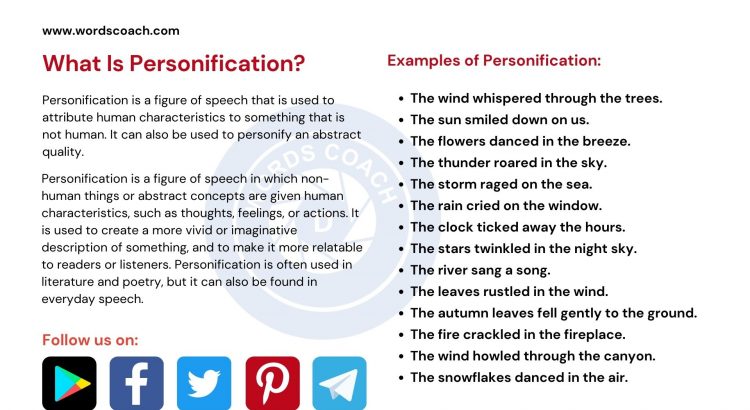Personification is a figure of speech that is used to attribute human characteristics to something that is not human. It can also be used to personify an abstract quality.
Personification is a figure of speech in which non-human things or abstract concepts are given human characteristics, such as thoughts, feelings, or actions. It is used to create a more vivid or imaginative description of something, and to make it more relatable to readers or listeners. Personification is often used in literature and poetry, but it can also be found in everyday speech.
For example, “the wind whispered through the trees” is an example of personification because the wind cannot literally whisper, but the comparison is used to create a more descriptive and imaginative image.
Examples of Personification
- The wind whispered through the trees.
- The sun smiled down on us.
- The flowers danced in the breeze.
- The thunder roared in the sky.
- The storm raged on the sea.
- The rain cried on the window.
- The clock ticked away the hours.
- The stars twinkled in the night sky.
- The river sang a song.
- The leaves rustled in the wind.
- The autumn leaves fell gently to the ground.
- The fire crackled in the fireplace.
- The wind howled through the canyon.
- The snowflakes danced in the air.
- The waves crashed on the shore.
- The rocks groaned under the weight.
- The car complained as it struggled up the hill.
- The lamp flickered, trying to stay lit.
- The book begged to be read.
- The moonlight kissed the water.
Personification Examples in Everyday Language
Literature is definitely the best source to understand how personification works. However, personification can be used in everyday life as well.
- The sun-kissed me while I was clicking a picture.
- The flowers danced to the wind.
- My clothes stood so erect as if someone had ordered them to stay in attention, as soon as I had ironed them.
- I felt like the food kept calling me.
- The stars were sparkling and winking at all of us.






